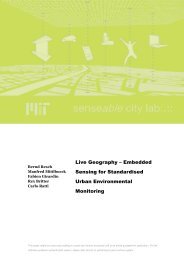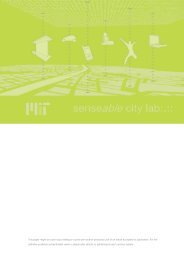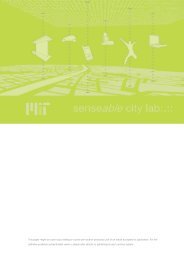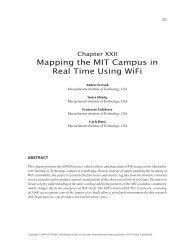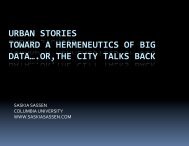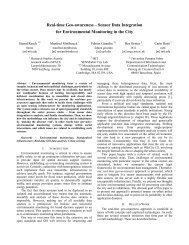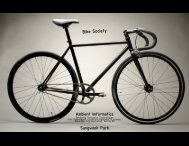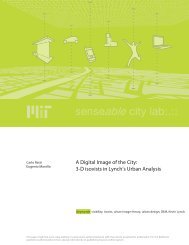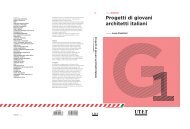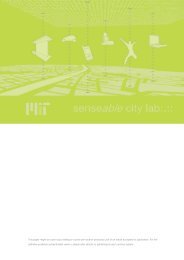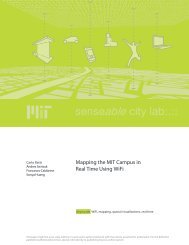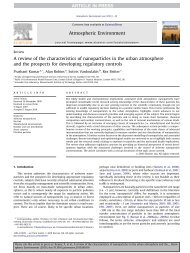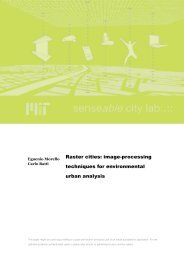Today - MIT SENSEable City Lab
Today - MIT SENSEable City Lab
Today - MIT SENSEable City Lab
Create successful ePaper yourself
Turn your PDF publications into a flip-book with our unique Google optimized e-Paper software.
U s e r - G e n e r a t e d C o n t e n t<br />
Digital Footprinting:<br />
Uncovering Tourists<br />
with User-Generated Content<br />
Novel methods and tools are being developed to explore the significance<br />
of new types of user-related spatiotemporal data. The approach<br />
described here helps uncover the presence and movements of tourists<br />
from cell phone network data and the georeferenced photos they<br />
generate.<br />
Fabien Girardin and Josep Blat<br />
Universitat Pompeu Fabra<br />
Francesco Calabrese,<br />
Filippo Dal Fiore, and Carlo Ratti<br />
Massachusetts Institute<br />
of Technology<br />
<strong>Today</strong>, it’s possible to gather every<br />
click of every move of every user<br />
who interacts with any software<br />
in a database and submit<br />
it to a second-degree data mining<br />
operation. Along with the growing ubiquity<br />
of mobile technologies, the logs produced<br />
have helped researchers create and define new<br />
methods of observing, recording, and analyzing<br />
a city and its human<br />
dynamics. 1 In effect, these<br />
personal devices create a vast,<br />
geographically aware sensor<br />
web 2 that accumulates tracks<br />
to reveal both individual and<br />
social behaviors with unprecedented<br />
detail. 3 The low cost<br />
and high availability of these<br />
digital footprints will challenge<br />
the social sciences, which have never<br />
before had access to the volumes of data used<br />
in the natural sciences, 4 but the benefits to fields<br />
that require an in-depth understanding of large<br />
group behavior could be equally great.<br />
Accordingly, this article illustrates the potential<br />
of user-generated electronic trails to remotely<br />
reveal the presence and movement of a<br />
city’s visitors. (This research was led at the Massachusetts<br />
of Technology, in collaboration with<br />
Universitat Pompeu Fabra.) We anticipate that<br />
validating these trails with respect to existing<br />
surveys might lead to an improved understanding<br />
of several aspects of urban mobility and<br />
travel. We therefore present several novel datacollection<br />
techniques, analytical methods, and<br />
visualization tools that we’ve been developing to<br />
uncover urban dynamics. Although the nature<br />
of digital footprints renders the information derived<br />
both more credible and reliable, we must<br />
further consider how to validate this pervasively<br />
user-generated content.<br />
In a previous work, we showed that explicitly<br />
disclosed spatiotemporal data from open platforms<br />
provide novel insights on visitor dynamics<br />
in an urban space. 5 Understanding population<br />
dynamics by type, neighborhood, or region<br />
would enable customized services (and advertising)<br />
as well as the accurate timing of urban<br />
service provisions, such as scheduling monument<br />
opening times based on daily, weekly, or<br />
monthly tourist demand. In general, more synchronous<br />
management of service infrastructures<br />
clearly could play an important role in tourism<br />
management.<br />
Working with Digital Footprints<br />
A city’s visitors have many ways of leaving voluntary<br />
or involuntary electronic trails: prior to<br />
their visits, tourists generate server log entries<br />
when they consult digital maps 6 or travel Web<br />
sites; 7 during their visit, they leave traces on<br />
wireless networks whenever they use their mo-<br />
36 PERVASIVE computing Published by the IEEE CS n 1536-1268/08/$25.00 © 2008 IEEE<br />
Authorized licensed use limited to: IEEE Xplore. Downloaded on December 4, 2008 at 08:13 from IEEE Xplore. Restrictions apply.



